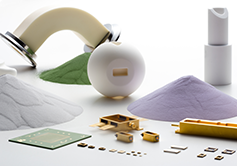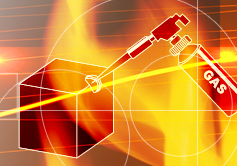Fine Ceramics, sometimes referred to as "advanced ceramics," are engineered materials that support the development of cutting-edge technology.
Strength (3)
Toughness—Highly Resistant to Fracturing
Typically, ceramics are characterized by hardness as well as a lack of toughness.
The toughness of a material is measured by its resistance to fracturing. Among Fine Ceramics (also known as "advanced ceramics"), zirconia possesses relatively high levels of toughness. As a result, it is used for products such as blades, scissors and knives.
Applications: Knives, scissors and other related products.


Description
Toughness
Fracture toughness measures a fissured material's resistance to fracturing (whether the fissures exist throughout the material or only on its surface).
The fracture toughness of Fine Ceramics is measured using the critical stress intensity factor KIC at crack terminations where fracturing generally occurs. In particular, the fracture toughness KIC value is used to compare material's shape when a fissure is opened by a plane deformation. Though Fine Ceramics generally possess low fracture toughness, partially-stabilized zirconia, used for products such as scissors and knives, offers significant fracture-toughness improvements.
Fracture Toughness

For more information, please see Excerpt of Graph Values.
The term "Fine Ceramics" is interchangeable with "advanced ceramics," "technical ceramics" and "engineered ceramics." Use varies by region and industry.
People who read this page also read.

Strength (1)
Strength (1)
Extreme Hardness Surpassing that of Metals
Extreme Hardness Surpassing that of Metals
Characteristics of Fine Ceramics

Strength (2)
Strength (2)
Rigidity—Less Elastic Deformation Compared to Metals
Rigidity—Less Elastic Deformation Compared to Metals
Characteristics of Fine Ceramics

Strength (4)
Strength (4)
Specific Gravity (Density) to Provide Strength and Lightweight Properties
Specific Gravity (Density) to Provide Strength and Lightweight Properties
Characteristics of Fine Ceramics

Different Types of Fine Ceramics
Different Types of Fine Ceramics
Wide Variety of Products to Support both Industry and Society
Wide Variety of Products to Support both Industry and Society
Introduction to Fine Ceramics
If you want to use ceramics in business, click here.
Kyocera's Fine Ceramics products (All websites below open in a separate window.)
Product Category
 Semiconductor / LCD Processing Equipment
Semiconductor / LCD Processing Equipment
 Life / Culture / Industrial Machines
Life / Culture / Industrial Machines
 Wireless Communications
Wireless Communications
 Computer Peripherals
Computer Peripherals
 Environmental Preservation / Renewable Energy
Environmental Preservation / Renewable Energy
 Medical Equipment / Devices
Medical Equipment / Devices
 Single-Crystal Sapphire Products
Single-Crystal Sapphire Products
 Metallized / Vacuum Components
Metallized / Vacuum Components
 Electronics Industry
Electronics Industry
 Heaters
Heaters
 Piezoelectric Ceramics
Piezoelectric Ceramics
Search by Material
 Alumina
Alumina
 Silicon Nitride
Silicon Nitride
 Silicon Carbide
Silicon Carbide
 Sapphire
Sapphire
 Zirconia
Zirconia
 Cordierite
Cordierite
 Yttria
Yttria
 Aluminum Nitride
Aluminum Nitride
 Cermet
Cermet
 Mullite
Mullite
 Steatite
Steatite
 Forsterite
Forsterite
Search by Property/Characteristic


- Thermal Properties
- Coefficient of Thermal Expansion
- Thermal Conductivity
- Heat Shock Resistance

- Electrical Properties
- Insulation / Semiconductivity

- Chemical Properties
- Chemical Resistance










